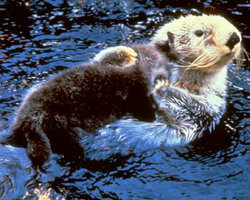Sea Otter
|
|
| Sea Otter Conservation status: Endangered | ||||||||||||||||
|---|---|---|---|---|---|---|---|---|---|---|---|---|---|---|---|---|
| | ||||||||||||||||
| Scientific classification | ||||||||||||||||
| ||||||||||||||||
| Binomial name | ||||||||||||||||
| Enhydra lutris (Linnaeus, 1758) |
The Sea Otter (Enhydra lutris) is a large otter native to the North Pacific, from northern Japan and Kamchatka west across the Aleutian Islands south to California. The heaviest of the otters, Sea Otters are the only species within the genus Enhydra.
Hunted extensively for their luxurious fur—the densest of all mammals with up to 100,000 hairs per square centimeter— from 1741 onwards, Sea Otter populations were greatly reduced to the point of extermination in many parts of their historic range. By 1911 the world population was estimated to be just 1,000-2,000 individuals. Although several subspecies are still endangered, the otters have since been legally protected, and reintroduction efforts have shown positive results.
| Contents |
Physical description
With long, streamlined bodies, Sea Otters are built for life at sea. Exceptionally dense brown fur insulates the animal and retains air, creating an effective barrier between the water and the skin; this is important, as the otters lack insulating fat. Underneath each powerful front flipper is a pouch of skin used to temporarily store food collected during extended dives to the bottom. The front flippers also have retractile claws, while the hind flippers are longer, broadly flattened and webbed. They have a fairly short, thick muscular tail.
Sea Otters have compact molars with smooth cusps; they are the only carnivores with no more than four lower incisors. These otters may reach a maximum weight of 45 kilograms (nearly 100 pounds) and a length of up to 1.5 metres (nearly 5 feet) in length. Females are somewhat smaller.
Habitat and diet
Sea_otter_2.jpg
Generally sticking to shallow coastal waters of no more than about 55 metres in depth, Sea Otters are found most often in areas with rocky coastline and thick kelp forests; barrier reefs and intertidal areas are also inhabited. These otters may be considered a keystone species; they control the population of certain invertebrates which would otherwise run amok if unchecked. Chief among these invertebrates are sea urchins, and abalone a favourite prey of the otters.
Without predators to keep their numbers down, these and other grazers would decimate a kelp forest. Abalone, crab, mussels, scallops, cephalopods, fish and chitons are also prey to the Sea Otter. Individuals may show finnicky preferences; despite this, they require 20-25% of their body weight in food each day.
The otters themselves are threatened mostly by humans and Orcas.
Otters frequently eat while floating on the surface of the water. Otters like to relax and groom themselves this way after a hunt, and also use this method to fill up their fur with warm air bubbles for insulation.
Behavior and reproduction
Sea Otters may be either solitary or in groups called rafts when resting; females avoid males outside of breeding periods. Conflicting data regarding home range and migration of Sea Otters suggests their movements are dependent on availability of resources. Home ranges may be as large as 5.4 square kilometres, with most animals travelling found within 1-2 kilometres of the previous day's location.
Diurnal animals, most of a Sea Otter's day is taken up by foraging and grooming. Feeding activity peaks in the early morning and evening (crepuscular feeding); dives are fairly short, typically lasting no more than about 90 seconds. The otters wrap themselves in mats of kelp, securing them from the sway of currents while resting and feeding. Floating on their backs, the otters wash and (if necessary) pry open their prey with a favoured rock they keep in their pouch. Sea Otters present a rare example of mammalian tool use.
No set breeding season is observed, but peaks occur from May to June in northern populations and January to March in southern populations. Sea Otters are polygynous: that is, males have multiple female partners. Bonding does occur between the sexes during the female's estrous, which lasts all of three days. During these periods males will defend their territories; there is very rarely actual fighting involved, with most disputes being settled by raucous posturing. Females have characteristic scars from the males' habit of holding the former's head in their jaws during copulation.
Courtship between otters is very playful. When the males and females are courting each other they tend to play around, swimming mischievously. Both the male and female otters swim and dive together, twisting and doing corkscrews in the water to let the female know he is interested. The male will also swim facedown and will swim more quickly than they would usually move.
Gestation is approximately 218 days, although it can be prolonged from several days to several months if the fertilized egg does not imediatly imbed itself in the uterine wall. During this suspension period, the egg reamins unmoving. This may occur because the stormy tendencies of seas may disrupt the implantation. Gestation usually ends in a single birth; twins are a rarity, and usually only one of them survives. Pups are born weighing up to 2.3 kilograms; they are able to eat solids very soon after birth. The brownish yellow pups are cared for exclusively by the mother whom they are dependent upon for six months or more. The mother is responsible for teaching the pups how to hunt, dive, and groom effectively.
Males reach sexual maturity at 5-6 years of age with most females mature by four years. Sea Otters lead relatively long lives of up to 23 years in the wild.
External links
- Animal Diversity Web: Enhydra lutris (http://animaldiversity.ummz.umich.edu/site/accounts/information/Enhydra_lutris.html)
- OceanInfo: Sea otters (http://oceanlink.island.net/oinfo/otterpage/otter.html)
- CNN: Alaskan Sea Otter population falls 70% in eight years, environmentalists sue U.S. Interior Department for protection (http://www.cnn.com/2005/TECH/science/06/07/alaska.otters.reut/index.html)ast:Llundria marina
da:Havodder de:Seeotter eo:Mar-lutro fr:Loutre marine it:Enhydra lutris nl:Zeeotter ja:ラッコ sv:Havsutter

